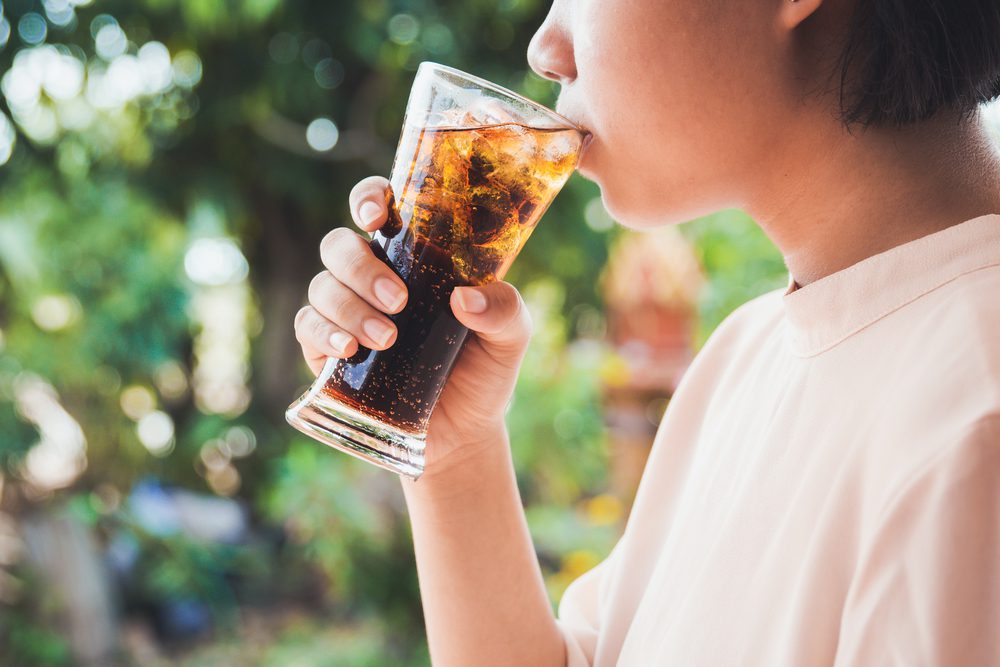Diabetes – one of the most common diseases on the planet right now and one we’re still trying to discover.
As I’m writing this post, more than 10% of our country’s population has been diagnosed with type 1 or type 2 diabetes. Sadly, another estimated 7.3 million people might already be dealing with this condition without knowing.
Some of the most common risk factors for diabetes are:
- Being overweight/obese
- Sedentary lifestyle
- Age (people over 50 are more prone to type 2 diabetes)
- High blood pressure
- Smoking and/or drinking alcohol
I know I fall into some of those categories; if you’re in the same boat, the best thing we can do is learn how to protect ourselves from complications.
Today, we’ll have a look at 11 of the most dangerous foods and drinks for diabetics and people at risk for this illness. Ready?

Sugary drinks
After more than two years after the pandemic, I think we all dream of sipping a delicious cocktail on a vacation or just drinking some ice-cold soda outside.
Before you run to the grocery store, though, wait!
Research has proven many times that drinks containing sugar can seriously harm the blood sugar levels for people with diabetes (or at risk for it). Why?
Firstly, they contain a concerning amount of carbs. For example, just a 12-ounce (354 ml) serving of Coke gives you 38.5 grams of carbs, already known for affecting insulin production.
Even fresh fruit or fruit-flavored juices contain way more fructose than you’d normally get by eating the whole fruit. Studies such as this one from the Journal of Nutrition proved high-fructose drinks can increase your risk of developing other conditions commonly linked to diabetes, such as fatty liver disease.
Some of the healthiest and most affordable alternatives you can enjoy are:
- Plain water
- Lemonade
- Homemade ice tea
Homemade smoothies and shakes are also some great options that help you reach your nutritional needs quickly. Our Shake It Up! Series has plenty of delicious recipes you can try using ingredients you have right at home, so check it out right here.
This next one should be easy to process…..
High-carb processed foods
Delicious as they may be, those late-night sandwiches or rice bowls can mess up your insulin levels instantly.
When we talk about high-carb, processed foods, we think about white bread, pasta, rice and all the products made using these ingredients.
Sadly, this includes most pastry goods, bagels and desserts.
All these foods can cause a spike in your blood sugar levels due to their high carb content. Additional studies such as this one showed that they can also affect multiple brain functions in people already diagnosed with type 2 diabetes.
The blood sugar spike is due to the foods’ high carb and low fiber content. Fiber is an essential nutrient that helps your body absorb sugar and process it correctly.
The solution in this case is to start looking for high-fiber foods and include them into your daily diet. The most popular options are:
- Oatmeal
- Nuts (you can pick your favorite)
- Fruits like citrus, apples and berries
- Beans
It’s all in the flavor?…..

Flavored yogurt
What would you choose between full-fat plain yogurt and a low-fat, fruit flavored one?
Most people would pick the second option which unfortunately is much worse than the first.
Here’s a rule of thumb: just because something is labeled as ‘low-fat’ doesn’t mean it keeps your waistline intact! In fact, most fruit-flavored yogurts are overloaded with sugar; sometimes, a single cup can give you more than 30 grams of sugar!
The same theory applies to frozen yogurt, which can be equally (if not more) sugary than plain ice cream. As you may already know, sugary drinks increase your blood sugar levels rapidly, a phenomenon known as ‘sugar rush.’
The downsize is that every sugar rush brings a sugar crush, which alters normal insulin production while leaving you hungrier than before.
If you want to play it safe, just make your own fruit-flavored yogurt by mixing full-fat options with fresh fruit. This option gives you more nutrients, it’s more fulfilling and keeps your gut healthy at the same time!
The next one is a real cereal killer…..
Breakfast cereals
Okay, I’m not including all breakfast cereals in this category, but let’s admit it: almost all of those colorful, crunchy cereals are highly processed and overloaded with salt and artificial ingredients.
Unlike plain oats, for instance, those colorful breakfast cereals contain a lot of carbs in the form of sugar which take your blood sugar levels through the roof. Many of them contain little protein, but what they do have is preservatives, food coloring agents and other artificial ingredients meant to trick your senses.
Once again, don’t let yourself be fooled by the ‘diet cereal’ labels, as many of these products aren’t healthy either! For example, just half a serving of granola gives you 44 grams of carbs and barely has 4 grams of protein.
Breakfast may or may not be the most important meal of the day for you; either way, it’s your first opportunity to give your body its much-needed dose of nutrients, thus preventing weight gain and other diabetes risk factors!
This next one should easily translate…..
Trans fats
This is perhaps one of the most difficult nutritional notions to explain; however, distinguishing the main types of fat is crucial for your long-term health.
The foods we eat contain at least one of these types of fat:
- Monosaturated – they’re very healthy and beneficial for your cholesterol, immune system and digestive tract.
Found in: avocado, olive oil, nuts - Saturated – can have a negative impact when consumed excessively, so it’s best to eat as little as possible.
Found in: deli meats, butter, burgers, some hard cheeses like cheddar - Trans – these are the bad guys you should stay away from. They increase cholesterol, as well as your risk of type 2 diabetes, cardiovascular disease and fatty liver disease.
Sadly, trans fats are found in so, so many foods around us. Almost every fast-food product and snack (think chips or biscuits) contains dangerous amounts of trans fats. What’s worse, these food categories are also addictive due to their high sugar and salt content, so it’s best to stay away from them as much as you can.
Maybe leave Jo alone?…..
Flavored coffee
Coffee lovers out there, I have some great (and not-so-great) news for you!
Firstly, the good news: consuming coffee is great for your cardiovascular health and may even help you manage your diabetes better or lower your risks if you don’t have it yet.
The bad side is that coffee can mess with your blood sugar levels the minute you start adding flavors and that unfortunately includes most of the goodies from Starbucks.
For example, one Caramel Frappuccino (16 ounces) gives you 57 grams of carbs – and most of them come as sugar.
Don’t get me wrong, you can still enjoy these beverages if you’re not already diagnosed with diabetes; however, it’s better to see them as a dessert rather than your daily dose of caffeine.
This next one is not so sweet (sort of)…..
Maple syrup/agave nectar/honey
They’re some of the healthiest ways of avoiding refined sugar while still enjoying sweet goodies. Honey also gives you a powerful dose of antioxidants, so what’s there not to like?
Well, these natural sweeteners can also cause a spike in your blood sugar levels that’s equally damaging to sugar (depending on how much you eat).
Here’s how many carbs you’ll get from a single tablespoon of the most popular sweeteners:
- Maple syrup: 13.4 grams
- Honey: 17.3 grams
- Agave nectar: 16 grams
- White sugar: 12.6 grams
Does this mean you should replace honey with white sugar just because it has fewer carbs?
No, because honey gives you the much-needed nutrients your body needs to stay healthy!
The only thing we should learn here is that natural sweeteners can affect blood sugar levels just as much as processed ones do. Consuming each in moderation is fine unless your doctor has already advised you otherwise.
Always best to DIY…..

Pre-packaged snacks
If there’s one thing very few people know about sugar, is that it’s added in most of the foods we eat – even in those that aren’t sweet!
Aside from that, packaged snacks such as crackers and pretzels contain refined flower as their main ingredient (which, as we know, can increase blood sugar levels rapidly). Although they may give you a false sense of satiety, these quick foods have almost zero nutrients, which alters normal hunger patterns and might lead to over-eating.
Remember how I told you that fiber is essential to process sugar into the bloodstream correctly? Well, here’s how much fiber some foods really have compared to their carb content:
- Pretzels: 20.7 grams of carbs and 0.78 grams of fiber
- Saltine crackers: 20.7 grams of carbs and 0.78 grams of fiber
- Graham crackers: 21.7 grams of carbs and 0.95 grams of fiber
Simply said, the fiber you get just isn’t enough to make up for all those bad carbs and empty calories.
If you’re used to snacks or just love the habit, you can find much healthier alternatives in the form of nuts or veggie sticks with homemade cheese sauce.
This next one is naturally surprising…..
Unsweetened fruit juice
Yes, you read that right. Unsweetened fruit juice is perhaps the most surprising item on the list for many people.
After all, how can something 100% natural not be healthy?
Well, the answer is simple: fruits are sweet because they contain fructose, and they’re healthy because they’re unprocessed and give you plenty of nutrients.
However, fructose can cause a spike in your blood sugar levels just as much as refined sugars do. Fresh fruit juice has a much higher concentration of fructose than eating whole fruits, so when your body gets it all in a few sips, your blood sugar levels go through the roof.
Just think about the fact that an 8-ounce can of soda has almost as much sugar as the same can of natural apple juice (22 and 24 grams).
Multiple pieces of research have proven that constant consumption of fructose can promote insulin resistance and heart disease in the long run.
If you’re looking for a sweet treat, you can eat whole fruits instead or any of the snacks mentioned on the previous page.
We like the French, but…..
French fries
Sorry to break it to you, but French fries aren’t bad just because they make you gain weight.
Firstly, potatoes are high in carbs by nature, as a single medium potato can give you up to 35 grams of carbs (and only 2 grams of fiber).
Even so, roasted or baked potatoes with other healthy ingredients on the side remain a healthy option you can pursue confidently.
However, if you take that potato and deep-fry it in vegetable oil, the results are devastating in the long run.
According to a review published in Critical Reviews in Food Science and Nutrition, the process of frying foods creates toxic compounds such as advanced glycation end products (AGEs). Such compounds can increase your long-term risk of cancer, inflammation and type 2 diabetes.
If you want a healthier alternative that resembles the texture of French fries, you can roast sweet potatoes as they’re much more nutritious.
This next one is less than fruity…..
Dried fruit
By now, we already know that fruits are loaded with healthy nutrients and fructose. Now, when you take a whole fruit and dry it, you’re basically packing all of its nutrients in a smaller product.
This means you can get more vitamins and minerals faster, but also more fructose – which can cause an instant spike in your blood sugar levels.
For example, a single cup of raisins gives you 115 grams of carbs, which is far higher than the amount you’d get by eating the whole fruit.
Does this mean you have to avoid fruits too? Not at all! Specialists actually recommend diabetics to include fruits into their diet as often as possible; just make sure you eat the whole fruit without added sugar or other sweet toppings.
Your takeout
Many foods and drinks can be misleading, so the best way to avoid them is to stay informed and listen to specialists’ advice.
If you’ve been diagnosed with diabetes or you know you’re at risk for it, you should start designing a diet that includes as little as possible from the following food categories:
- Processed grains (such as refined flower)
- Sugary beverages
- Foods high in refined carbs (think pretzels)
- Sweeteners
Living with type 2 diabetes (or at high risk for it) isn’t easy – and we know it. That’s why here at Wellness Captain one of our main goals is to spread expert-verified information to keep our readers healthy in simple ways.
Our most popular diabetes posts might help you too, so check them out below:
8 Natural Ways You Can Reverse Diabetes
Before you go… are you or a loved one dealing with diabetes right now? Share your journey and tips in the comment section and let’s help each other to live long, happy lives together!













